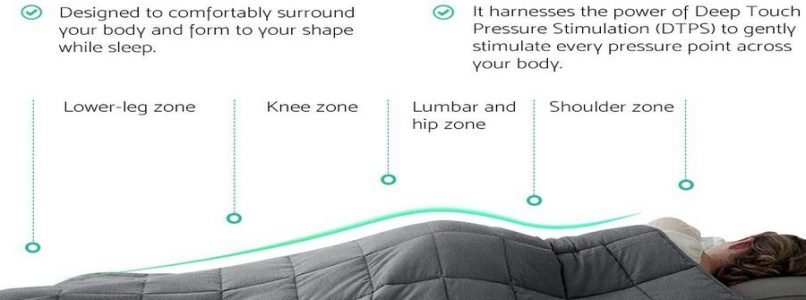The first weighted blanket was invented by Keith Zivalich in 1998. Keith revealed in an interview that the idea of a weighted blanket came when his 10-year-old daughter placed a beanie teddy bear on his back to keep him company through his journey. When this unique idea was made popular, scientists in the field of medicine and therapy saw the medical benefits of the weighted blankets. Actually, weighted blankets create a sense of warmth and relax the mind by providing pressure on the body. They are made to physically look like regular blankets but are filled with glass or plastic beads and have more layers. Furthermore, weighted blankets work on the theory that increased pressure on the body leads to an increase in the release of serotonin and oxytocin. Serotonin, also called “the happy chemical” is produced by the brain when there is a feeling of confidence and calm. Likewise, oxytocin is produced by the brain when there is a feeling of social trust, safety and calm. If you need more detailed information or would like to buy a weighted blanket, just visit the Mela website and their customer service will gladly help you.
Let’s now discuss who should use weighted blankets and who shouldn’t.

Who should and should not use a Weighted Blanket?
- Weighted blankets are usually used by Attention Deficit Hyperactivity Disorder (ADHD) patients. ADHD is a condition that includes hyperactivity, impulsiveness and general inability to control one’s emotions.
- People who always need a deep and strong hug use weighted blankets.
- People that find it difficult to sleep at night also use weighted blankets. The pressure emanating from the blanket prevents frequent body movement, making the user concentrate on the present task of sleeping.
- Children under 2 years of age should not use weighted blankets to avoid suffocation
- Asthmatic patients should not use weighted blankets.
- Individuals that are claustrophobic should not use weighted blankets.
Benefits of Weighted Blankets
Aside from their most popular advantage of inducing sleep, there are a lot of medical benefits associated with using weighted blankets. They include:
- Weighted blankets reduce anxiety and increased heart rates for ADHD patients. Check out what Mayo Clinic says about this.
- Help to improve a bad mood
- They are used as a pressure therapy
- Help to reduce chronic leg and body pain.
Disadvantages of using Weighted Blankets
Everything that has an advantage has a disadvantage and weighted blankets is not an exception. Some disadvantages of using weighted blankets are:
- A weighted blanket may suffocate a very young child.
- If the plastic or glass pellets fall off, children might swallow them and it will lead to a more complicated situation.
- Weighted blankets are very costly when compared to regular blankets.
- Honestly, it is not easy to find the right blanket for someone. Although it is advised to use a weighted blanket that is 5% of a child’s body weight and 10% of an adult’s body weight, the right weighted blanket is peculiar to every individual.
In conclusion, it has been established that the use of weighted blankets is excellent for stress relief, however, to be on a safe path, you should consult a specialist before using this pressure therapy for your child.

